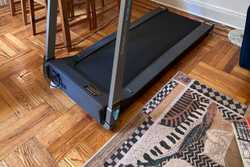How to Choose an Electric Bike: The Ultimate E-Bike Guide

Our evaluations and opinions are not influenced by our advertising relationships, but we may earn a commission from our partners’ links. This content is created by TIME Stamped, under TIME’s direction and produced in accordance with TIME’s editorial guidelines and overseen by TIME’s editorial staff. Learn more about it.
Electric bikes are a game-changer for cyclists, giving you more power for less pedal over a range of classes and types. Knowing which are the best electric bikes to choose from can be a tricky business, though, so we’ve enlisted a panel of e-bike experts to walk us through all the ins and outs. Follow the advice below, and you’ll know how to choose an electric bike that suits you best..
“The electric bike class system is an e-bike classification that has been developed only in the U.S. (you won’t find it in Europe) by People For Bikes,” explains Max Renson, general manager at Upway, an online retailer for new and certified pre-owned electric bikes. “The goal of this clarification is to help inform and regulate a still very new industry. E-bikes will be classified depending on their type of assistance and their maximum speed.”
| Class 1 | Class 2 | Class 3 |
|---|---|---|
Max speed of 20 mph | Max speed of 20 mph | Max speed of 28 mph |
Motor only provides power when you pedal | Motor provides power both while pedaling, or when using the throttle without pedaling | No-pedal throttle laws vary by state: Some allow them, some do not |
Some may have a throttle or “boost,” but it only works when pedaling | ||
Good for: Someone who needs an extra boost but doesn’t need to go too fast | Good for: Beginners, and people who want a little help getting going from a full stop | Good for: Experienced riders using an e-bike on busier roads |
Here, Renson breaks down the advantages and disadvantages of each class:
As with regular bicycles, e-bikes come in a range of different styles, designed for different purposes:
“The most traditional type of e-bike, commuter e-bikes typically have good range (20 to 50 miles), rain fenders, integrated lights, strong motors, and enough torque to help get you up hills quickly,” says Tyler Swartz, co-founder of E-bike Commuting, adding that he’s a fan of the Priority Current e-bike in this category.
Read, Also: Best Electric Commuter Bikes: How to Choose the Best E-Bike for You
“Most e-mountain bikes will be Class 1 only,” adds Stuart Sundell-Norlin, associate category merchandise manager (bikes) at Christy Sports. “Designed to pedal, many top brands are designing these machines from the ground up around the ride performance–think modern mountain bike geometry and features, but with some added power.” He recommends checking out the Trek Fuel EXe.
Read, Also: Best Electric Mountain Bikes for Trails and Treks
“These are commuter e-bikes on steroids,” says Sundell-Norlin. “Designed for increased weight limit and carrying capacity, they may come with larger built-in storage [either at the front or back, known as ‘longtail’ or ‘front-loader’], or be adapted for passengers utilizing seating and guards where needed to protect additional riders. Usually, they have a longer frame design that’s built around heavy loads–a bit cumbersome, but purpose built.” Swartz suggests Rad Power’s RadWagon 4 as a good place to start.
Read, Also: Best Electric Cargo Bikes for Easy, Two-Wheeled Hauling
“Folding e-bikes are designed to fold down, making them easier to carry and store in apartments or take onto public transit,” says Swartz. “However, it’s important to note that e-bikes that fold are generally heavier than traditional folding bikes. These bikes often weigh upwards of 65 pounds, requiring significant strength and stability to lift and maneuver when folded. If portability while folded is a priority for you, it’s crucial to look for a lightweight folding e-bike. My personal favorite is Gocycle's G4i.”
Read, Also: Best Folding Electric Bikes to Make Travel a Breeze
“Cruisers are suitable for short rides on flat roads,” says Swartz. “They are typically Class 1 e-bikes with a smaller motor and battery. A great option in this category is the Priority E-Classic Plus cruiser—it features a high-quality motor and a well-designed frame, providing a comfortable and enjoyable riding experience.”
“Performance road e-bikes are designed for speed and long-distance riding on paved roads,” says Renson. “They often have lightweight frames, drop handlebars, and efficient motors. They’re usually more expensive—it’s difficult to find a good recommendation here, but we like the entry-level Domane+ from Trek, one of the best seller models of e-road bikes.”
What is an electric bike made up of, exactly, and what features should you be paying attention to? Let’s take a look.
“There are two common types of motors that provide power to an e-bike, mid-drive and hub-drive,” explains Swartz. “Mid-drive motors are located in the thru-axle, where the pedals connect to the frame of the e-bike. They offer several benefits, including a more natural pedaling experience due to the motor's proximity to the pedals, higher torque for faster acceleration, and better utilization of the bike's gearing, especially when tackling steep hills.”
“Hub-drive motors are located in the center of the rear wheel,” Swartz continues. “They are typically less expensive than mid-drive motors and are known for their durability and reliability. Personally, I prefer mid-drive motors because they provide the most natural biking feel, unlike hub drive motors, which can feel like someone is pushing you. Mid-drive motors make it feel like you have really strong legs!”
Batteries are rated by watt-hours (WH), with a higher WH rating indicating a larger capacity (“Think of a 700WH as being a bigger gas tank than a 500WH battery,” says Sundell-Norlin).
Renson adds that batteries have a finite number of charge cycles, with most having 500-1,000.
“Ensure the e-bike's power output aligns with your needs,” advises Renson. “More powerful motors (wattage) provide stronger assistance and can handle steep hills and heavier loads.”
“Any accessory you'd put on an analog bike is still in play,” says Sundell-Norlin. “From panniers to bells, baskets to fun color grips and fenders. And with lots of great app offerings, a phone mount is a great starter accessory for all. Don't forget a good electric bike lock, and always wear a helmet!”
“E-bikes are typically heavier than regular bikes due to the inclusion of an electric motor and battery,” says Swartz. “Personally, I prefer e-bikes that have batteries located in the down tube rather than on the rear rack. Batteries positioned on the rear rack, above the rear tire, can cause an unusual weight distribution. When standing and pedaling, the entire bike may sway back and forth as the battery shifts.”
Here, Sundell-Norlin lists the average weights of different types of e-bikes:
“Consider the frame style (high step, low step, or mixte) that suits your comfort, riding preferences, and mobility,” says Renson. “Consider also the weight of your cargo–usually, low steps are easier to mount and help avoid your cargo from oscillating too much. Look for front or full suspension if you plan to ride on rough terrain, and assess the saddle comfort and handlebar type for your riding style.”
“Buying from reputable brands and ensuring local support will greatly help if and when issues arise,” says Sundell-Norlin. “Your local bike shop can perform mechanical adjustments but may be limited in software/firmware updates to brands they carry. But buying from your local bike shop will be the best way to manage future service.”
“An electric bike starts with traditional bike components, associated with an electric motor and a battery system to provide assistance (pedal or pedal and throttle),” says Renson.
“With Class 1 and 3 e-bikes, you start by pedaling to propel the e-bike forward,” Renson continues. “The pedal motion triggers sensors that detect your pedaling effort, activating the electric motor. The motor provides additional power to assist your pedaling effort, making it easier to pedal and increasing your speed. Most e-bikes have a control interface on the handlebars, which allows you to adjust the level of assistance. Most e-bikes are also equipped with the same derailleurs as mechanical bikes, allowing you to change gears while you ride.
“For Class 2 ebikes, on top of the pedaling assistance, you have the option to use a throttle on the handlebars,” concludes Renson. “This allows you to accelerate and maintain a constant speed without pedaling.”
“E-bikes require some additional maintenance compared to traditional bicycles due to the presence of electrical components like motors and batteries,” says Renson. “The frequency at which you maintain your e-bike doesn’t differ too much from a traditional bike, but the number of components to be checked is higher.”
Below, you’ll find Renson’s advice for looking after your e-bike:
If you’re looking for a folding e-bike, this is one of Swartz’s favorites. “It’s impressively fast, comfortable to ride, and is incredibly lightweight at only 33.7 pounds,” he says, also citing how natural it feels to ride, and adding that he believes the more expensive price tag ($5,499) is worth it.
![[object Object] [object Object]](https://gocycle.com/us/wp-content/uploads/sites/3/2022/01/2022-Gocycle-G4i-black-14_webstore-1.jpg)
When it comes to hauling Cargo, Swartz suggests taking the RadWAgon 4 for a spin. Relatively inexpensive at $1,799, its 750W motor can haul up to 350 pounds of cargo or passengers (you can fit two!).
![[object Object] [object Object]](https://www.radpowerbikes.com/cdn/shop/products/WagonBlack_side1to1_900x.png?v=1696952421)
Looking for a more adventurous ride? Sundell-Norlin advises the Trek Fuel EXe, an e-mountain bike designed to give you assistance where you need it, without interrupting the feel of your ride. Be warned, though, they’re pricey, coming in between $5,499.99 and $13,999.99, depending on your frame choice.
![[object Object] [object Object]](https://media.trekbikes.com/image/upload/w_800,h_600,c_pad,f_auto,fl_progressive:semi,q_auto/FuelEXe8GXAXSUS-24-41550-A-Primary)
As you can see from all of the above, there’s a lot to consider when choosing an e-bike, including what you need it for, which class is right for you, whether you’re able to keep up with the required maintenance, and of course, whether the price is right for you. E-Bikes are definitely an investment, costing anywhere from around $1,000 for an entry-level model to over $6,000 (and potentially much more) for higher-end e-bikes, so you need to be certain you’re making the right choice. Buying certified, pre-owned models is another option to find the best cheap electric bikes on the market, as well.
“With more options than ever, pick the bike for the purpose you need,” advises Sundell-Norlin. “Stop into your local bike shop, say hello, and they'll have an expert who can guide you through the myriad of options and get you rolling in comfort and style.”
“The lifespan of an e-bike battery can vary significantly depending on several factors, including type, brand, how it's used and maintained, and environmental conditions,” says Renson. “Generally, e-bike batteries are designed to last for a certain number of charge cycles, after which their capacity gradually diminishes.”
To better take care of your battery, Renson advises keeping it clean, avoiding physical damage, and adhering to storage recommendations, all of which will help extend its life. He also warns that extreme temperatures, both hot and cold, can negatively impact battery lifespan.
Class 1 and 2 e-bikes are legally mandated to have a top speed of 20mph, while Class 3 e-bikes have a top speed of 28mph.
“Some direct-to-consumer e-bikes start as low as $1,000, and premium e-mountain bikes and road options can exceed $14,000—it’s very much a story of, you get what you pay for,” says Sundell-Norlin. “On the commuter side, around $2,500 seems to be a great balance of price vs. quality. In the mountain/road premium categories, expect to spend $5,000 - $7,500 in the middle of the market.”
“Range is usually a function of your battery capacity,” says Renson. “The higher the capacity, the more range you can expect. You can also find bikes with two batteries integrated for increased capacity and range, but they’re usually heavier bikes.”
For bikes with decent range, Renson recommends the following:
“The best electric bike wattage depends on the rider's needs,” says Renson. “Wattage typically refers to the power output of the motor.” Since e-bike motors can have a wide range of wattage, Renson explains the most common categories below:
“Some e-bikes have gears just like a regular bike,” says Swartz. “However, many have fewer gears because the added power from the motor means you don't need to change gears as much to get up a hill.”
The information presented here is created by TIME Stamped and overseen by TIME editorial staff. To learn more, see our About Us page.



